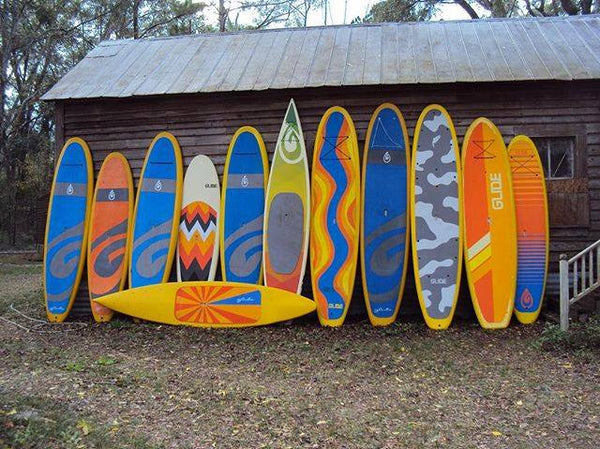
The Ultimate Guide to Selecting Your Ideal Paddle Board
You have discovered a new love for stand up paddle boarding and you want to purchase a paddle board for yourself but there are so many choices. Let us walk you through the process methodically.
Introduction

Welcome to the world of SUP paddleboarding, a realm where the tranquility of calm waters meets the thrill of adventure. Whether you're gliding through serene lakes on a paddle board, mastering the art of stand-up paddle (SUP) yoga, or speeding across the water to boost your endurance, the right paddle board is your ticket to an unforgettable experience. Our comprehensive buying guide dives deep into the essentials of choosing a board that not only matches your paddleboarding ambitions but also enhances your connection with the water.
Embarking on Your Paddle Boarding Journey
Perhaps your paddleboarding spark was ignited on a borrowed board at a local lake, and now you're ready to find the perfect paddle board to call your own. Whether you're a newcomer eager to soak up expert advice or an experienced paddler looking for advanced insights, this guide is your gateway to finding the paddle board that resonates with your lifestyle and paddleboarding dreams. From deciding between an inflatable SUP board and a rigid one to selecting the right size for your adventures, we cover all the bases.
Inflatable vs. Rigid Paddle Boards: Making the Choice

Inflatable paddle boards are often the go-to for beginners, offering easy storage and transport without compromising on stability. The key to an exhilarating ride lies in choosing a high-quality inflatable SUP, characterized by multi-layer PVC construction and woven drop-stitch technology, ensuring rigidity and performance. On the other hand, those with ample storage and a penchant for traditional paddleboarding might lean towards rigid boards, known for their durability and sleek performance thanks to EPS foam cores and robust fiberglass finishes.
Sizing Up Your Paddle Board
The quest for the perfect paddle board starts with understanding board size. Your choice will be influenced by your weight, the board's length, and its width. For beginners, a paddleboard in the 10-to-11-foot range offers a balanced blend of stability and maneuverability. As you evolve, you might find yourself drawn to longer, narrower boards designed for speed on flat water. Remember, the right board supports your weight comfortably, ensuring a smooth and enjoyable paddleboarding experience.
Exploring Board Types: From Yoga SUPs to Racing Titans
Your paddleboarding aspirations dictate the type of board you'll need. Yoga enthusiasts might opt for wider boards that provide a stable platform for poses, while adrenaline seekers might gravitate towards sleek racing SUPs designed for velocity and agility. Touring boards, with their displacement hulls, are ideal for long-distance adventures, offering storage for overnight essentials. And let's not forget the versatile all-around SUPs, perfect for those who love to dabble in everything from serene paddles to thrilling surf sessions.
Finessing Your Paddle Boarding Experience with Fins and Deck Pads
The right fins and deck pad can dramatically enhance your paddleboarding. Flexible rubber fins are a must for river adventurers, reducing the risk of damage in shallow waters. Meanwhile, a quality deck pad ensures comfort and grip during long paddles, making your experience more enjoyable and fulfilling.
Concluding Thoughts: Finding Your Perfect Paddle Board

Choosing the right paddle board is a journey of self-discovery, blending your living situation, paddleboarding skills, and aspirations. By considering the factors outlined in our guide—from board type and size to the specific features that suit your preferred paddleboarding activities—you're well on your way to finding a board that not only meets your needs but also elevates your paddleboarding adventures to new heights. Embrace the journey, and let the perfect paddle board find you, paving the way for countless memories on the water.
Related Topics
Things to Consider When Buying a SUP
Improving Fitness on Paddle Board
Can I Leave My Paddle Board Inflated?


